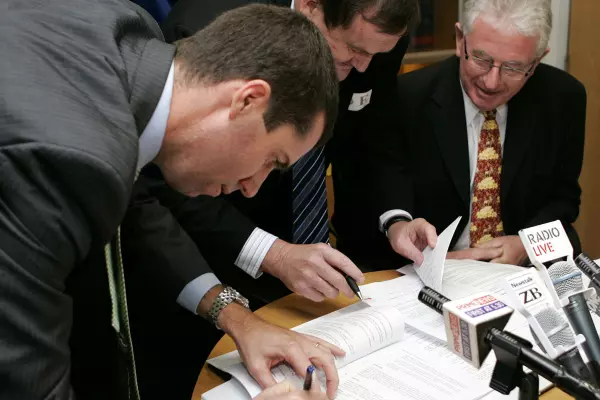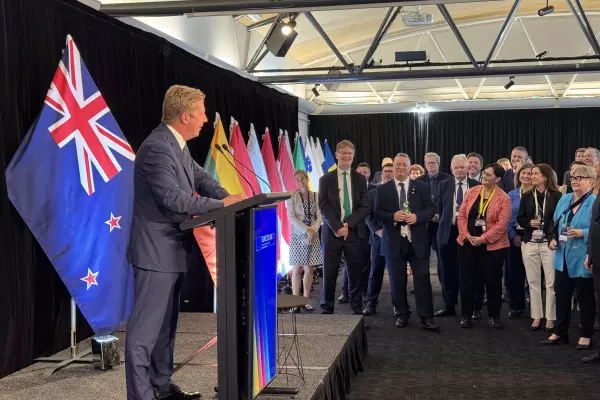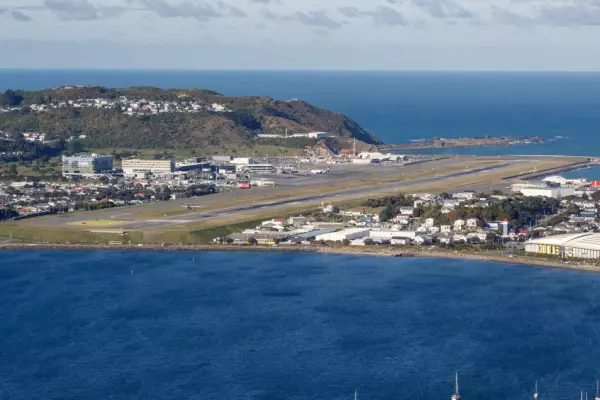As the flames die and the smoke clears on the roof of the unfinished New Zealand International Convention Centre roof, questions from this sorry episode spin out in many directions.
There are the simple questions: how did it start? Whose individual incompetence, error or negligence put the latest spanner in the works of a $700 million project that has become synonymous with cost over-runs, delay and, increasingly, litigation?
There are systemic questions: this was already a troubled project, awarded to Fletcher Building on a bid that was so low it cost the company hundreds of millions of dollars in writedowns and contributed to the demise of the previous chief executive. The company withdrew for a time from 'vertical construction' projects. The convention centre was already behind schedule and the subject of contract disputes and withheld progress payments.
Just last week, the chair of SkyCity's international convention centre sub-committee, Richard Didsbury, told shareholders at the annual meeting that Fletcher's performance had been "abysmal".
Is this fire simply the most dramatic symptom so far of the lack of scale, productivity and professional capacity in the New Zealand construction sector, which is straining at the seams with current levels of demand? As journalists pressed Fletcher chief executive Ross Taylor about whether workers from the site were still being paid, he was more worried about hanging onto his workforce while the fire damage and repair project are assessed because there's so much work available elsewhere.
Is the fire an equally dramatic expression of New Zealanders' belated embrace of a professional attitude to workplace health and safety? Only a WorkSafe investigation, likely taking months, will answer that question.
Armchair experts
There are the armchair expert questions, such as: why is straw and bitumen used to make the roofs of commercial buildings in 2019? To a lay-observer, this seems both crazy and olde worlde, yet is apparently not unusual. The roof of the Spark Arena on the Auckland waterfront is made of similar stuff, executives from Fletcher Building and SkyCity said yesterday.
There are the commercial implications. The project is said to be well-insured and there's no reason to think otherwise. There should be no doubt that the project can be completed, but SkyCity will clearly be facing more delayed cashflow because of a further delay in the centre's opening, while Fletcher will presumably be looking at further losses on a project it is now morally bound to complete.
Taylor was emphatic about that in yesterday's press conference, stressing the company has plenty of balance sheet depth to deal with a remediation process that will likely involve a considerable amount of demolition and complete reconstruction. Insurance industry observers reckon that Fletcher would almost certainly have raised the sum insured for the project after it realised it had under-priced the job.
But there could still be wrinkles. If there have been any significant building code changes since the project was signed off earlier this decade, new designs and budgets may yet be required for parts of the project.
APEC looms
Then there's the question of the fire's implications for Auckland's role as host of the 2021 APEC Leaders Summit, an opportunity to showcase New Zealand's largest city on the global stage, in which a spanking new convention centre should have been the centrepiece.
When Auckland last hosted APEC, in 1999, it cost the country $44 million and about 5,000 people turned up for the main event. For APEC 2021, the Treasury estimates a cost of around $234.5 million, with somewhere between 9,000 and 12,000 visitors filling almost every available bed in the Leaders' Week, with barely enough beds, even assuming completion of various hotel projects currently underway.
One tiny note of optimism: the convention centre hotel may not have suffered much, or any damage. Even if, as Auckland mayor Phil Goff quickly concluded, the convention centre itself isn't ready for business in November 2021, foreign dignitaries should at least be able to bed down in the centre's new hotel.
But it does mean either a return to the Aotea Centre, the main venue for the 1999 event and the 1995 Commonwealth Heads of Government meeting, or some other sub-optimal venue that is as yet undisclosed. Contingency plans exist, but no one was discussing them yesterday.
"The NZICC is the preferred venue for APEC 2021 meetings in Auckland and it is too early to make any decisions as to whether the preferred venue needs to change," said Nick Hill, the chief executive of the city's events and economic development agency, ATEED. "As with any project of APEC’s magnitude, there are contingency plans in place around New Zealand’s and Auckland’s intended venues."
So, at this early stage, there are no answers.
While the fire is nothing like the scale of the Canterbury earthquakes, the muscle memory among government agencies and private sector construction firms may still be fresh enough to provide the coordination and rapid focus to get the convention centre back on track faster than appears likely at present.
Only one thing is sure: the fire has shaken central Auckland to its core, bringing the central business district to a standstill and underscoring how vulnerable a city's progress can be to one small, but catastrophic, mistake.
(This story has been updated to reflect that there were more factors in the previous Fletcher Building ceo's exit than issues associated with the convention centre.)




